The Chamber of Demonstrations
Reconstructing the Jacobean Indoor Playhouse
Click here for a downloadable pdf of the text.
PRACTISING THEATRE HISTORY AS PERFORMANCE
Martin White
Introduction
Much current scholarship in the field of Elizabethan and Jacobean drama, including my own, focuses on the actual performance of plays in their own or later periods, regarding the texts that survive as, in different ways, blueprints for performance, and exploring them in the context of their performance spaces, actors and theatre-practice and of other agencies such as audiences that impact upon those texts in performance. My own research in these areas is largely conducted through practice.
But let me just sketch a brief background. In 1998, a sea-change occurred in the lives of arts (as opposed to humanities) researchers in the UK, with the creation of the Arts & Humanities Research Board (now Council) which, for the first time, funded practice-led research in the creative arts. I cannot stress too heavily the impact this had on the landscape of research in the performing arts.
That's not to say, of course, that research through practice had not been conducted before then. If I take my own department at Bristol as an example, scholars such as Glynne Wickham, Richard Southern and Neville Denny were experimenting from the early 1950s by staging medieval and early modern plays, and using their findings in their published work.

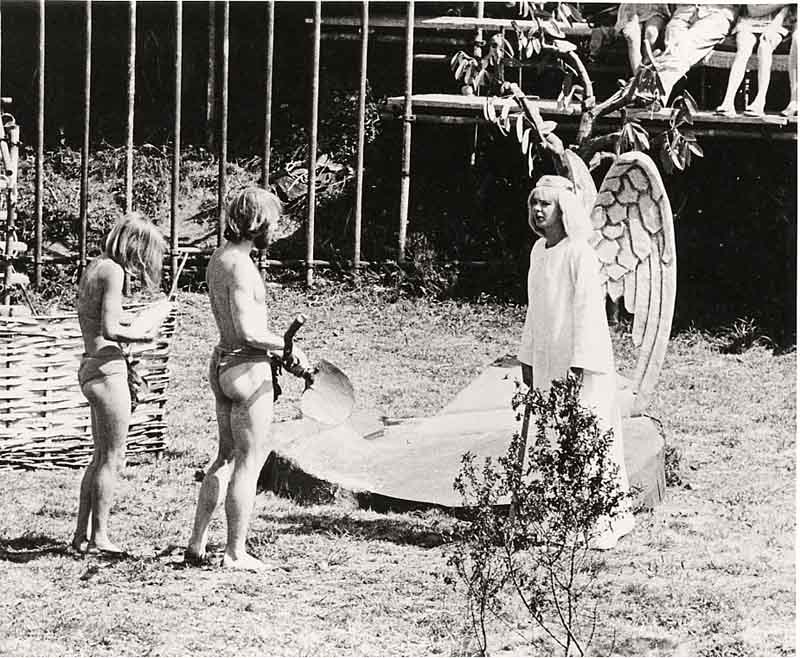
But the arrival of the AHRB not only provided funding for practice-led research in the academy, but in so doing, confirmed it as being as valid and - not to be underestimated - as respectable as research conducted through more traditional or conventional means. And - a point to which I shall return - it opened up debates not only on how such research might most profitably be conducted, but how it might be disseminated in forms other than the books or journal articles that had predominated - and be disseminated, in fact, through the practice/performance itself.
Practice as Research
I am focusing on two modes of practice as research in early modern drama and theatre studies:
First, are performances, in the professional or university theatre, of neglected plays - either by well known writers or those who have disappeared off the radar of the repertoire, even, in some instances, of academic interest: precisely what we have been fortunate enough to see here in the past few days. In 1827, Charles Lamb lamented that about two thirds of extant early modern plays were still generally unknown, either in print or performance. While the number in print has increased, the number performed on the professional stage, while larger, is still comparatively small, although (in the professional theatre) the Read Not Dead seasons at the Globe in London and the RSC seasons at the Swan in 2002 and 2005, and many university contributions, have been instrumental in opening our eyes to the stage-worthiness of a number of neglected plays.
In this category, plays may be performed in configurations that are sympathetic to the original, but will not be determined by such decisions. In other words, they will solve production problems via the resources of our stage, not through a speculative recovery of past practices. Although, in my experience, it is possible that we might, on seeing such revivals, ask with the Gallian king, in the anonymous King Leir, 'When will this scene of sadness have an end, / And pleasant acts ensue to move delight'(ll. 1232-3), this is, in my experience, very rare. I'm immune now, when I advertise a production of a little-known play, to the easy jibes that we can all imagine why it's been neglected. To this audience I don't need to explain the quirks of theatrical fashion that have led to remarkable plays - even whole playwrights - sinking from sight, sometimes to re-emerge only to sink again. In 1923, William Archer pondered how:
'While Webster, Ford and Tourneur have been lauded to the skies, Massinger has been treated almost as a negligible quantity. And why? Simply because we seldom or never find in his work those patches of verbal poetry on which nineteenth-century criticism fastened its attention; and because he had not the gift of those unexpectednesses, if I may so call them - like the famous "Cover her face: mine eyes dazzle: she died young" - which had come to be regarded as the final proof of dramatic genius.'
In other words, the playwright didn't please the critic's preconceptions, rather like Webster's view of an ignorant audience more interested in new, than good, plays.
And I want to stay with Massinger for a moment.
Generally speaking, experiments in staging untested plays are more common in the universities than in the professional theatre, where the commercial risk is often too great and repetition rules the day. In a sense, this makes the decision of the RSC (admittedly a funded company) to mount two recent seasons at the Swan in Stratford upon Avon dedicated to staging neglected early modern plays even more commendable - and surprising. Again while the Swan is a sympathetic space (many consider it the perfect space in which to stage indoor plays in particular) and while there is no interest in any archaeological work on the play, considerable attention is paid to texts and other contextual materials.
Ideally, in my view, these two activities - university and professional theatre - should be linked. In Spring of 2001 I announced a production of Massinger's Believe As You List. Eventually licensed in 1631, after a not uncharacteristic bit of bother with the censor, and possibly performed in that year, Massinger's play (which survives in an autograph manuscript, marked up for stage performance) was not published until 1849, following the manuscript's discovery in a pile of rubbish. There is no recorded performance since its own time.
The play is based on the story of Sebastian, the deposed King of Portugal, transformed in Massinger's censor-busting second version, to King Antiochus, king of the Lower Asia, and relocated to the ancient world and not recent Europe.
By the time I staged the play, the terrible events of 9/11 had taken place, and - application being a trade now just as in Jonson's day - the story of a middle-Eastern leader, opposed to and pursued by a mighty military power, was seen as eerily topical. Indeed, many thought the play chosen in the light of 9/11 or had been textually adjusted to sharpen its applicability. Neither was true.
What emerged from the student production was a fine play - richly characterised, with a fantastic global sweep in its action, that explored in a way that made sense to our day, the human weakness of men and women, lost in a 'labyrinth of politic windings' and their personal freedoms and beliefs vulnerable and subject to the 'necessity of state'. But its performances in Bristol were seen, perhaps, by 500 people, and no trace remained except in a few photographs and those peoples' memories.
At my suggestion, the RSC 2002 season had included Massinger's The Roman Actor (which I was editing for the Revels series). I was appointed overall consultant on the 2005 season, and when Gregory Doran (Chief Associate Director at the RSC) asked me for suggestions I was confident, on the evidence of my own production experience, to recommend Believe As You List. Greg had the nerve to include it (little known playwright, totally unknown play) and it emerged as one of the hits, critically and with audiences, of the season.
In 1977, Anne Barton had written that: 'The Roman Actor is indeed a brilliant tragedy (RSC and National Theatre please note)', and, though we had to wait a while, I would argue, it was the collaboration between scholarship and practice that helped, however haltingly, to open our eyes and our ears to the vibrant theatrical qualities of Massinger’s work.
My second category is where the production, while meeting the pressing commercial demands of the professional theatre, is also seeking to produce research outcomes and discoveries. And the prime example of this category currently is the work undertaken in reconstructed spaces such as the Globe in London or the Blackfriars in Staunton, Virginia.
I want briefly here to sketch in some history of reconstruction.
The impulse to understand the physical nature of Shakespeare’s theatre - and, unfortunately, one cannot separate the person from the building in this story, which has put too much emphasis on trying to reconstruct the Globe rather than the Fortune or, until recently, the Rose - starts in 1767, when Edward Capell, seventh editor of Shakespeare's Works, first called for an investigation into 'the stage he appear'd upon, its form, dressings, actors . . . as every one of those circumstances had some considerable effect upon what he compos'd for it.'
In 1790, Edmond Malone became the first scholar to have access to the papers of the impresario, Philip Henslowe, and his son, the actor, Edward Alleyn, which detailed their artistic and business dealings at the Rose and Fortune playhouses. Malone tried to set out the material conditions under which Shakespeare's plays were first performed, systematically forging the link between textual study and performance.
Gradually, the idea emerged of actually reconstructing a playhouse. In the 1830s, the German novelist and translator Ludwig Tieck, working with the architect Gottfried Semper, proposed a reconstructed playhouse, to be built in Dresden, based on the contract for the Fortune. His plan was never realised, but Tieck's own passion stimulated others to try. It was in England, however, that the first serious attempts were made to reconstruct the playing conditions of Elizabethan drama, where William Poel made the first sustained attempts in the UK to recreate performances of English early modern plays according to the principle (as he wrote in the programme for his 1895 production of Comedy of Errors) that 'Shakespeare's plays should be accorded the conditions of playing for which they were designed'.
In April 1897, Poel sketched plans for a 1:24 scale model of the Globe, intending it as a maquette for a full-scale reconstruction which, he hoped, would be adopted as the venue of the National Theatre, a project then under discussion.

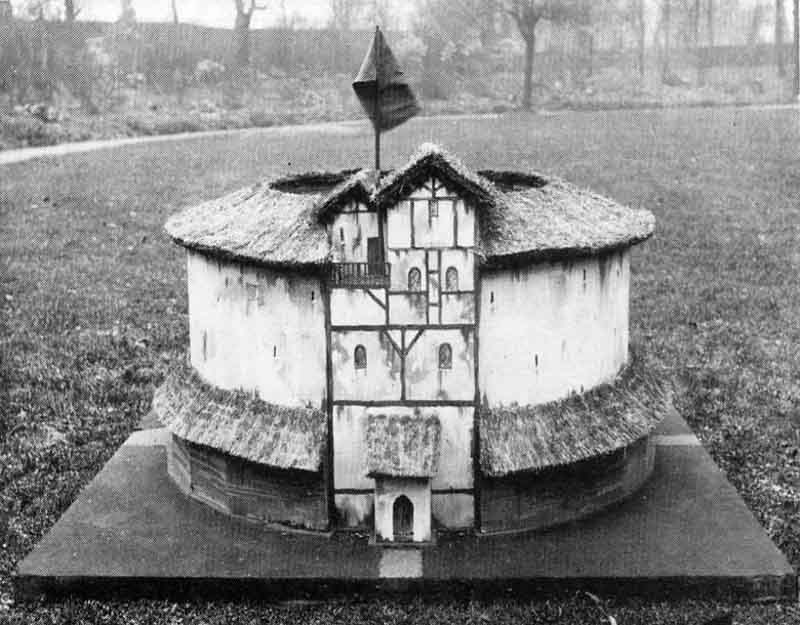
This ambition was never realised and, prior to the current reconstruction - or perhaps, more accurately, recreation - of a Globe playhouse in London, the last full-scale recreation (and itself the first to be built in post-Restoration England) was that designed by Edwin Lutyens for the 'Shakespeare's England' exhibition at Earl's Court in 1912.

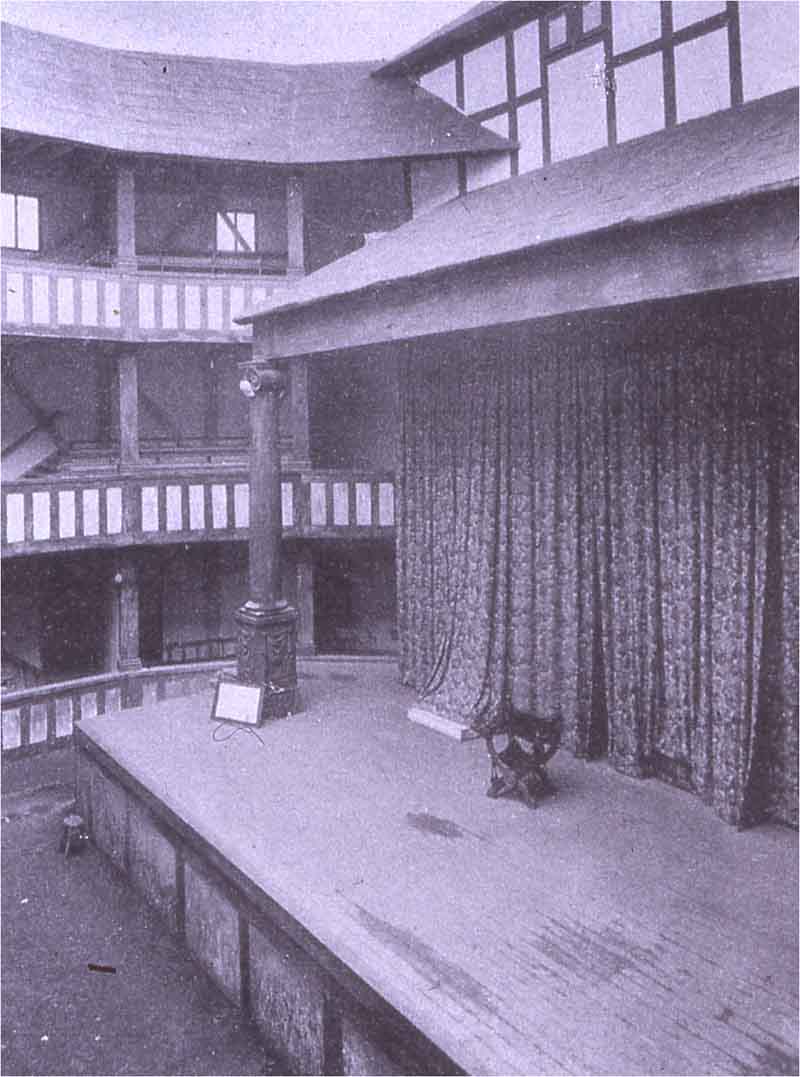
On this stage, a company known as the Idyllic Players performed extracts from plays by Shakespeare and his contemporaries, with actors in Elizabethan dress enacting their version of a contemporary audience. That building, unlike the current project in Southwark, had no educational purpose. By March 1905 even Herbert Beerbohm Tree, the apogee of illusionist stagers, was experimenting with a virtually bare stage surrrounded only by black drapes. But although Poel's own production achievements were limited, his experimental work was instrumental in influencing the approaches more successful directors (Granville Barker, Tyrone Guthrie, etc) took to staging Shakespeare.
In the United States, around the turn of the 19th/20th centuries, George Pierce Baker had been experimenting with Elizabethan staging in adapted spaces at Harvard, and at the 1934 Chicago World's Fair, Thomas Wood Stevens built a working Globe Theatre reconstruction, based on designs by JC Adams, for the English Village portion of 'A Century of Progress'.

It is this Globe that first drew a young Sam Wanamaker's attention to Shakespeare.

The following year, the San Diego Globe was built from the same plan as the Chicago Globe, but without a roof over the yard.

Other fairs in Cleveland, Dallas, and numerous other (and more loosely interpreted) adaptations were built, and the impact of these reconstructions and interpretations helped stimulate the rise of Shakespeare festivals in America.
Today, there are ten reconstructions (to different degrees of accuracy) of Elizabethan public playhouses around the world. Mostly these are of, or inspired by, the Globe: most recently, in Rome, and with proposals for Globes in Staunton, VA, Gdansk in Poland and on Governor's Island, New York. Others have looked to more secure models: the skeleton Fortune at UWA or the planned reconstruction of the Rose in Lennox, Massachusetts.
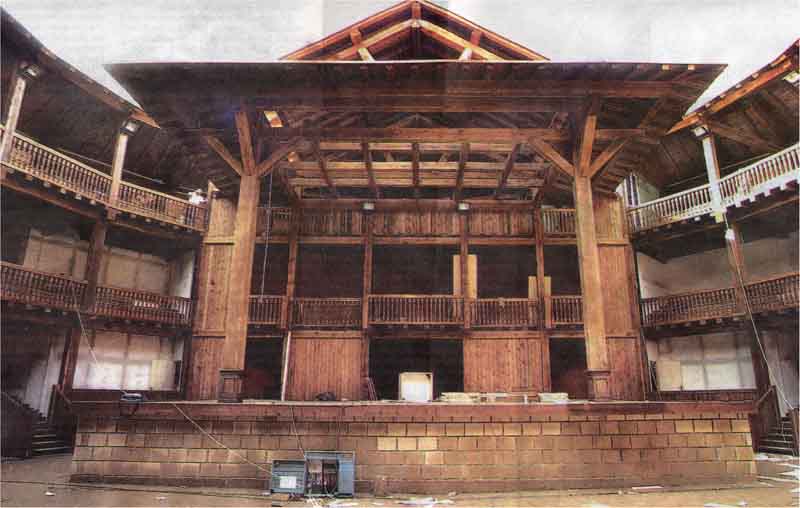
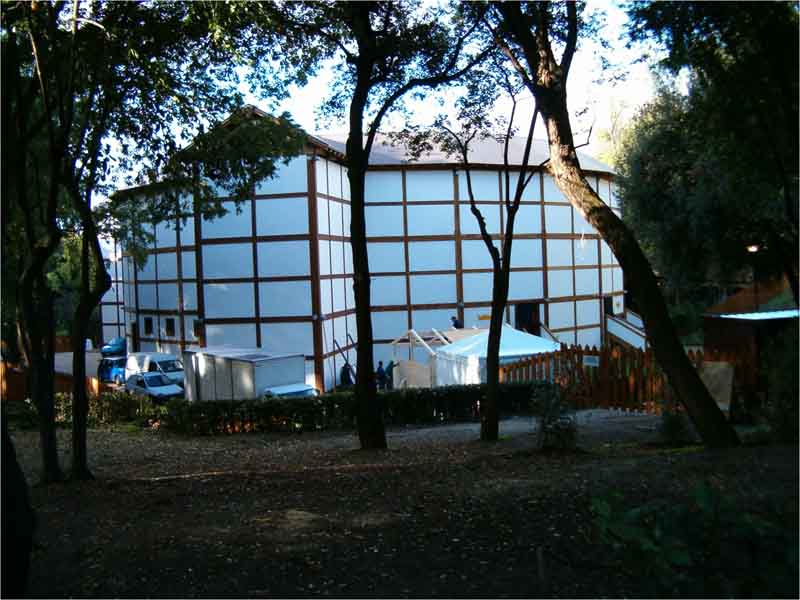
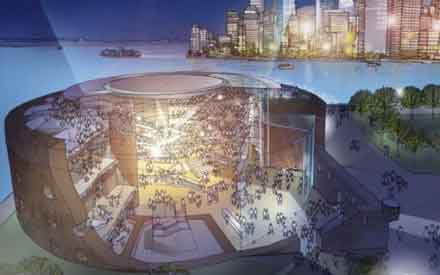
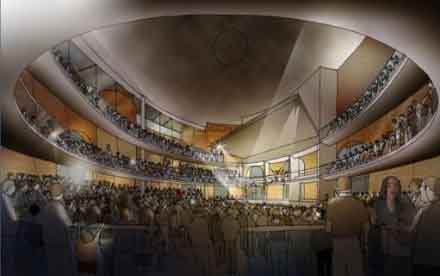



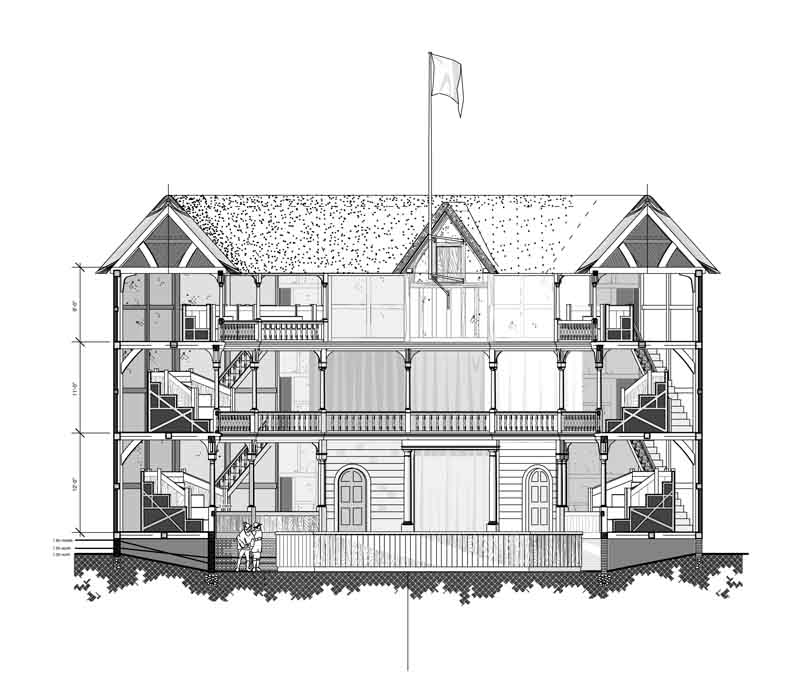

What has defined the London Globe, which is a collaboration - not without its tensions - between craftspeople, scholars and theatre artists, is its commitment to research. There is, consequently, so far as the research aspect of the Globe is concerned, a need to consider carefully the range of plays performed. Some repertoire choices and production approaches - such as the opening production of Two Gentlemen of Verona (dressed in modern Armani), Damian and Pythias with an all-female cast, or A Mad World, My Masters (a play that was not conceived to be, and never was, performed outdoors to 3000 people, but indoors to an audience of around 100) can offer only chance insights.
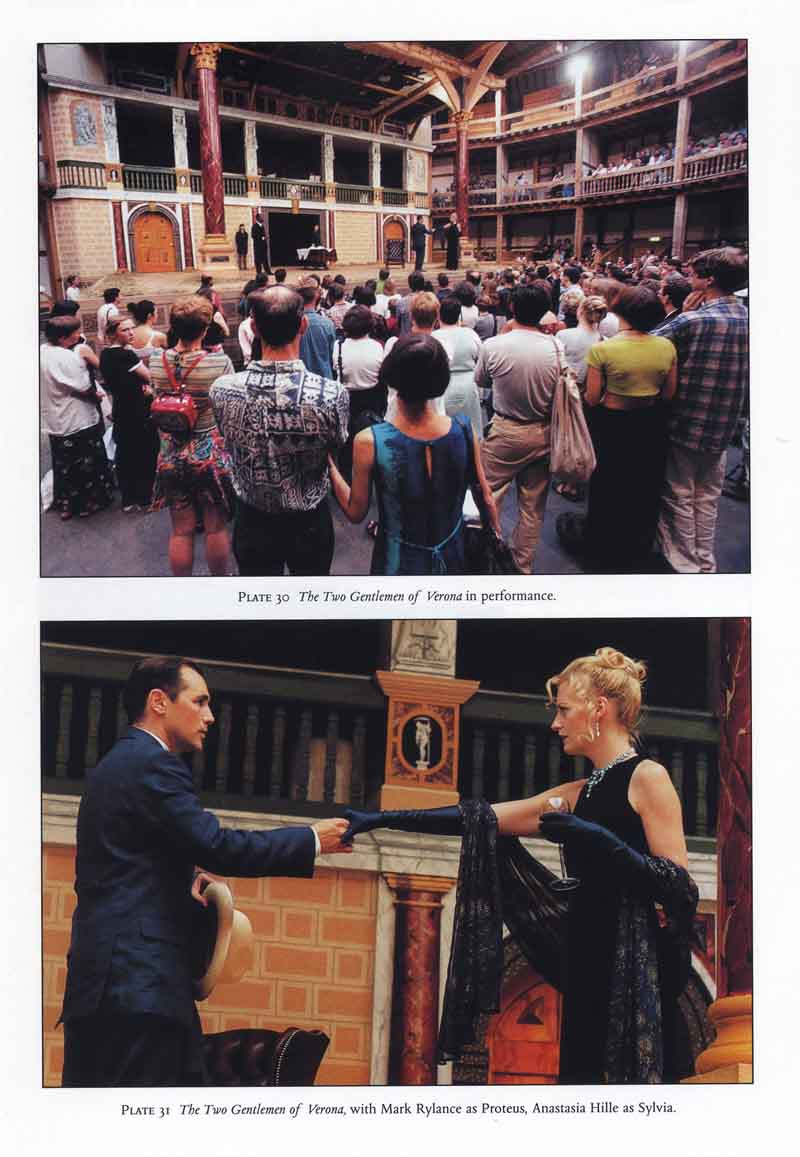
However, not only has the Globe project produced the single largest timber-frame building on a circular plan since the 17th century, but its exploration of early modern theatre practices - what the Globe calls 'original practices' - has resulted in a range of discoveries and confirmations of ideas that before were even more speculative. Currently, these ‘original practices’ - seen in productions such as Twelfth Night and Henry V -- are currently on the back-boiler, and the theatre currently operates as any playhouse, if a rather distinctive one.

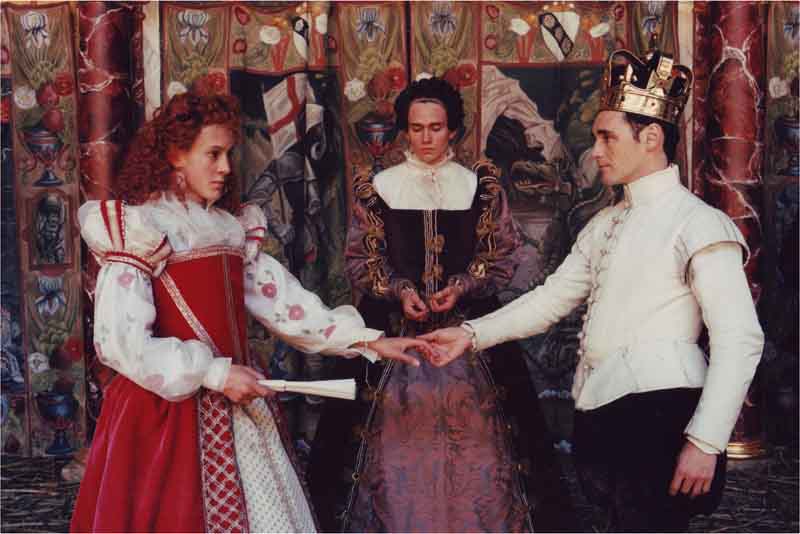
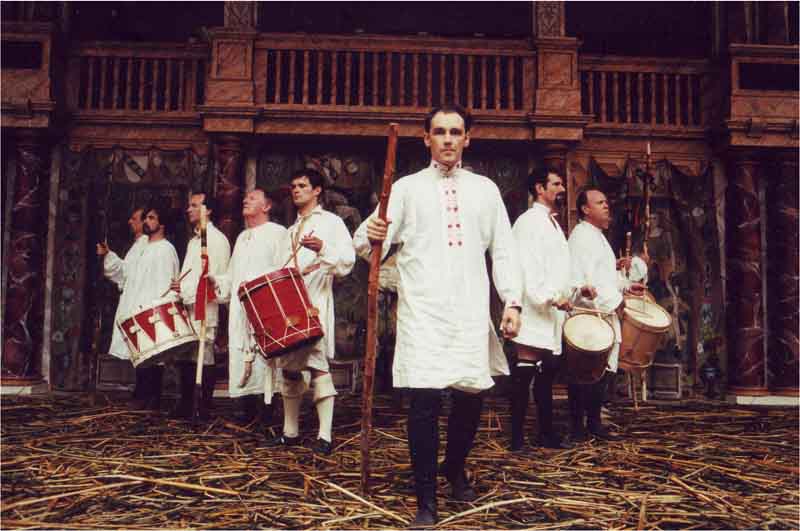
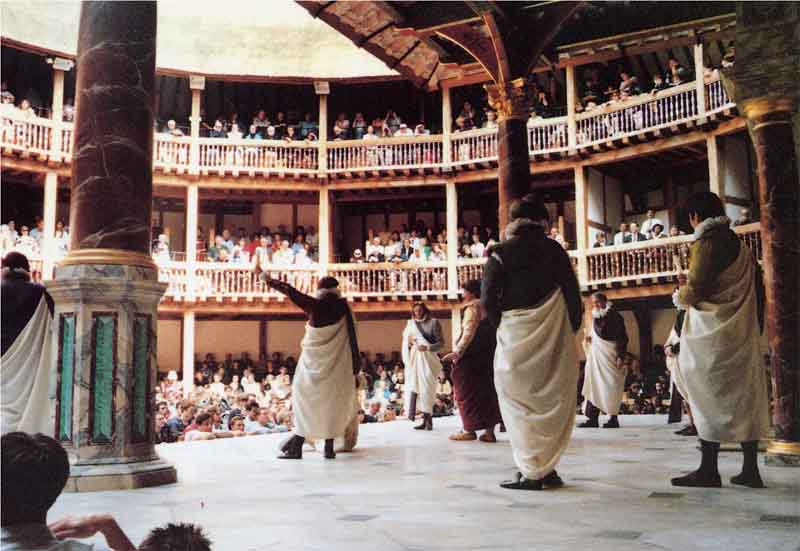
The scholarly, theatrically investigative work possible at the Globe (or any comparable structure) equates to laboratory experiment in which, utilising a three-dimensional tool, one can measure and test assumptions or discoveries about particular texts and implications for their performance in a way simply not possible without that facility.
This work on theatre practice is based on the axiomatic link between stage languages (physical and verbal) and the performance space in which those languages are articulated. This is particularly relevant in the case of Elizabethan and Jacobean playwrights whose plays were frequently tailor-made to suit the particular company who commissioned them: the opportunities offered by the performance space and the talents of the actors who would be likely to be cast in particular roles. As the Printer of The Two Merry Milkmaids reminds us:
'Every poet must govern his pen according to the Capacity of the Stage he writes to, both in the Actor and the Auditor.'

Indeed, while we tend today, as the collections of plays for sale in bookshops show, to group Elizabethan and Jacobean plays by author or genre (3 Jonson Comedies, 3 Revenge Tragedies, for example), it would be far more appropriate to group by playhouse and so identify the powerful determinant on a writer (any writer) of the material circumstances of production of his work. This, in turn, should develop editorial practices and clarify issues such as timing of entrances, overlapping entrances, balanced entrances, etc.
Others see the methods and potential of reconstruction rather differently, such as the production projects either realised or proposed by Robert Sarlos of the University of California at Davis and Alan Woods at Ohio State, or those undertaken some years ago by Tom Lawrenson at the University of Lancaster. Professor Sarlos aims to 'transport viewers and listeners . . . into a past age', and to this end he suggests that:
'all conceivable theatrical and non-theatrical elements of make-believe should be employed. Noises, scents, and other stimuli external to the work itself, but characteristic and evocative of the place and time, should be courageously, imaginatively, and forcefully recreated and exploited.'
He wishes to produce:
'the kind of experience that, by means of consequent contemplation, leads to a new, more complete, and more enlightened narrative. Minimally, it ought to result in a sophisticated summing up of intuitive insights into sensual and emotional aspects of theatrical style, derived from the performance.'
So, what do we learn? From the Globe, to date, I would list:
Music – instrumentation outdoors, positioning, cueing;
Costume – actors performing in clothes made with as much attention to detail as the building itself; opportunities and constraints of dress;
Use of stage - actor/audience relationships
Beyond that is the exploration of those elements of the stage that are often acknowledged in discussion - pillars, 'discovery space', upper level, etc. - but the implications of which - in practice - are not always fully understood. Even serious, stage-centred commentators can overlook what, in practice, have turned out to be problematic issues. J.L. Styan's 1967 book, Shakespeare's Stagecraft, is rightly acknowledged as a pioneering work. In it, however, he makes only two brief references to stage pillars, and sums his view up thus: 'The stage posts…do not call for more than cursory reference'. None of his diagrammatic illustrations of staging includes pillars. In practice, their size, position and impact on performance for actors and audiences continue to prove the knottiest item on the Globe stage.
Similarly, the often-repeated notion of the Elizabethan stage as a 'neutral' space has to be modified by anyone who has seen - and felt the impact of - the highly decorated frons, an impact that will be even further enhanced by the painting of the interior (new research project). Interestingly, many visitors to the Globe find this the least satisfactory aspect of its design - oak, plaster and lime-wash, the 'Anne Hathaway's cottage' syndrome, being for them more satisfyingly 'Elizabethan'.
And what can we not? Most who work in areas of reconstruction (not necessarily early modern) would agree that there are two main areas of the theatrical process and reception that cannot be reconstructed - acting style and audience response.
Acting styles
Professor Sarlos, Alan Woods (in his experiments with Italian Renaissance tragedy) and Pierce Baker also have attempted to recreate acting style. This is, in my view, too elusive a quarry.
But what can be explored, are the material factors that would have helped shape the style of performance in Elizabethan and Jacobean playhouses, as they do the work of all actors in all periods, foremost of which is the physical environment. The major task of the performers is to activate the whole playhouse, trying (as yet not always successfully) the dead, but still powerful, hand of the proscenium. Within this scheme, actors must explore actor/actor and actor/audience relationships (particularly the proximity and location of the spectators in what is a theatre-in-the-round, if an unevenly distributed one); the nature of the lighting (natural and artificial - indoors and out); the use of music to underscore the action; positioning of actors (i.e. blocking); conventions of gesture; staging set-pieces such as duels, dumb shows and banquets; the question of sight-lines and other, often more contentious issues, such as the use of the yard in performance. But the aim must not be to seek rules: there are, and, I suspect, never were, such things, and no room for them, in the live theatre, which is a constantly evolving - and essentially pragmatic - art form. A further purpose is the examination of more general principles of performance of a Elizabethan or Jacobean text - use of doors, props, furniture, levels, empty and full stages etc. - that emerged and explore how the discoveries might inform performance today.
At the same time, modern actors and audiences of Elizabethan plays find opportunities for self-absorption in the action, as clearly their Elizabethan counterparts did too. In Heywood's AWKWK, the suspicious husband, Frankford, with his servant Nicholas, returns unannounced in the middle of the night to his house to see if his fears of his wife's fidelity are justified. The combination of stage-whispering and appropriate action (Nicholas's line 'I will walk on eggs this pace' gives us a very clear idea of the implicit performance), matched by the audience's engagement, can create perfectly the appropriate mood and atmosphere. Indeed, the line 'A general silence hath surprised the house' may well describe the tension in the playhouse during the scene.
This pattern of shifting between 'detached self-awareness' and 'engagement' suggests to me a depth and intensity of contrast similar to the striking chiarascuro of Renaissance painting. I believe this pattern offers a clue as to how Elizabethan actors - partly by shifting the 'depth of focus' - sought to control audience response, something their modern counterparts at the Globe admit can be difficult.
Audiences
In 1895, Pierce Baker, preparing a production of Epicene, saw one of his tasks as being 'to drill Harvard students to represent an Elizabethan audience', which involved 'grooming' them into 'fops, gallants, citizens' etc, in carefully choreographed sequences of loitering, even fighting. When Theatre Studies Departments (Theatrewissenschafte) were first founded in Germany in the 1920s, reconstructions of past theatres and performances were rapidly developed as a means of investigation. Opposition to this method, however, focused on the fact that as theatre is essentially a two-way relationship between stage and audience, and as the historical audience cannot, by definition, be reconstructed, such an approach was fundamentally flawed.
But the presence of the audience can illuminate the crucial relationship between text and architecture. Derek Peat, working on the Fortune reconstruction in UWA, observed how the repetitions within longer speeches allowed the actor to directly address different sectors of the audience.
The play-texts certainly imply a receptive audience, able and ready to respond to the provocations of the play and assumed by the playwrights to be capable of entertaining irreverent attitudes and sceptical opinions. And we need to consider the impact, too, of a sectored audience. For example, in King Lear, Lear speaks the dangerous lines:
'See how yon justice rails upon yon simple thief. Hark in thine ear: change places and, handy dandy, which is the justice, which is the thief.'
In the modern theatre this line must remain an intellectual idea. At the Globe in 1606, however, with its heterogeneous audience distinguished not only in their dress but by their location in the playhouse, the identification of thief and justice - underlined by their very distinct, physical 'places', Lord's Room and yard, and the ability of the whole audience, watching in daylight, to see each other - would have been especially potent. We may not be able to recover that entirely - though there are padded chairs and there is the yard - but it reminds us of a dynamic in Elizabethan theatre to exploit faction rather than assume a shared, homogenous response, and play it out in seated twilight.
Certainly, the most striking aspect of performances at Globe 3, and what distinguishes performances there from ALL other venues (many of which share many of the Globe's physical characteristics), has been the impact on performers and performances of a standing audience. This has released a sense of audience energy, mobility and involvement more akin to that experienced at a football match - or, perhaps, Brecht's boxing match. Indeed, watching the moving mass of this audience from the vantage point of an upper gallery, I have been repeatedly struck by the sense of a crowd with the power to shape and influence the action on stage - a trace, perhaps, of the popular force that the Elizabethan and Jacobean authorities were fearful the playhouses could incite. Playing Shakespeare at the Globe may recover some of its excitement.
Trying to draw these two key drivers of theatrical performance together, Mark Rylance, until 2006 Globe 3's Artistic Director and leading actor (a very Elizabethan combination), is clear that the relationship between actor and audience at the Globe is 'genuinely unique and awakening'. He explains:
'The contrast between presentation and play, between showing something and playing it, is another feature that attracts me to experimental work at the Globe. It will be very difficult to 'present' a play there, to present a 'solution' to a play. An audience responds to playing. The idea of the word 'playing', and a space that demands play, could be very beneficial to the acting profession. To create a space like the Globe, where playing is all, will I hope benefit and refresh theatre performance generally.
Conclusions
Mark Rylance wants to''create a space like the Globe, where playing is all, will I hope benefit and refresh theatre performance generally'. The 'generally' is the key point. I would challenge strongly the notion that reconstructions are implicitly 'backward looking' - that they seek, for a whole range of dubious motives (often subsumed within the term 'heritage theatre') to recreate a lost past. Of course, one of their functions is to explore past practices, to understand them more comprehensively than we might otherwise. There is also, no doubt, for some visitors an element of cultural time-travel, and much work needs to be done on the place of 'cultural reminiscence' involved in visits to the Globe: i.e. what does an audience 'fill in' - or indeed re-read - from its own sense of 'Elizabethan'?
I firmly believe that working with a reconstruction can reveal information of value not only to students and scholars of the seventeenth-century theatre, but also to modern practitioners who can only benefit from an understanding of the mechanics of the plays as understood by their originators, before they create their own realisations.
There are also implications for the design of modern performance spaces. At the end of his stimulating book, Architecture, Actor and Audience, Iain Mackintosh lists what he sees as the key elements essential to successful theatre design. Interestingly enough, many of these are directly applicable to what we know of the theatre buildings of the late sixteenth and early seventeenth centuries and experience at the Globe - that it is not necessary''for all the spectators to see equally and perfectl''; that''a single-tier auditorium is...more difficult for the actor to animate'; that 'a more comfortable audience is generally less alert.…Hard benches for all'; that there is a need for 'a dynamic space animated by cross-currents of energy'.
Similarly, many contemporary stage designers, responding to spaces sympathetic to the plays, or to production styles that (even in unsympathetic spaces) seem to recognise the nature of the original staging practice, have produced work that would not have looked out of place on the stage at the (Elizabethan) Swan. Just as screen representations of the plays have to deal with the disparity between a generally 'realist' medium and metaphoric and theatrically self-reflexive texts, so stage representations must beware of over-riding, or making redundant, the visual content of the stage language. As Webster observed, the''centre is the actor' - his words, his gestures, his relationship to other figures on stage, to properties, furniture, and to the physical structure of the playhouse and its audience, played out in constant and full light. For all our talk of architecture we should remember that focus - the actors are the focus, but least discussed element, of the de Witt drawing.
This, I suggest, will be a feature of experiment at the Globe, and that such work is likely to shift radically the way we read, study and stage Elizabethan drama in generally. It seems enough to ask of any venture.
And how would I sum up my experience of my own, and others', work on reconstruction? I’d misquote the American writer, Lincoln Steffens: 'I have seen the past, and it works.'